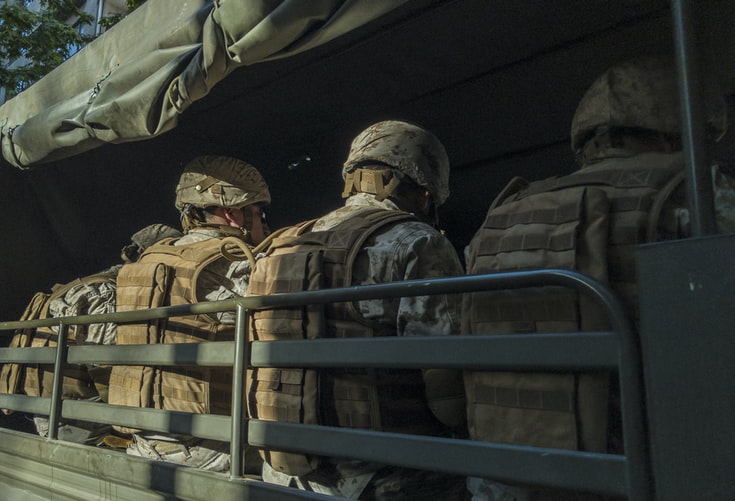
Social Secretary Ella Kipling discusses how through access to high school students, Military Recruiters target vulnerable low-income students with recruitment tactics.
The US Military’s recruitment tactics have been an increasingly controversial topic of conversation over the years, with many people feeling that they target low-income and vulnerable high school students. As someone from the UK, I find it strange to imagine what it would be like to constantly see recruiters in the school hallway or the cafeteria, but that is a common reality for many students across the United States.
In 2002, President George Bush signed the ‘No Child Left Behind Act,’ a piece of legislation that required military recruiters to be granted the same access to high school students as college recruiters. Since the military draft ended in 1973, the US military has relied on an all-volunteer service, which has led to the targeting of high school students during the recruitment process. The presence of military recruiters in American high schools is not an uncommon sight, and over the years recruiters have been accused of targeting low-income areas with recruitment tactics.
Jenny, a junior at Santa Maria High School, said that she ‘began to notice a strong military presence’ at her school. She said: ‘I expressed my concerns but I felt uncomfortable as my principal, an ex-military man, put me on the spot with questions about why I felt the way I did about military presence at our school. As if it was totally normal to have recruiters and presenters in our classrooms multiple times each week.’ Reporters in Connecticut found that recruiters made 10 times as many visits to one low-income school as they did to a nearby affluent school. For young people in low-income neighbourhoods, joining the military is often presented as a chance to escape poverty and grant them access to a higher education they may not otherwise be able to afford.
“Joining the military is often presented as a chance to escape poverty and grant them access to a higher education they may not otherwise be able to afford
By the 1980s, the term ‘poverty draft’ had gained traction as a way to describe the belief that the enlisted ranks of the military were made up of young people with ‘limited economic opportunities.’ Finnian L from Hoggard High School told the New York Times that he was ‘disgusted by the ad campaigns trying to brand the military as a way to get out of college debt.’ Program Coordinator for the Project on Youth and Non-military Opportunities Rocio Cordova describes the idea of the ‘poverty draft’ as a ‘draft-like system that pushes non-privileged people into enlisting because they lack access to jobs, income, and educational alternatives in their communities.’ Isn’t it sad that there are so few other options to receive further education for those less fortunate?
The Seattle Times reported that in 2004 all of the Army’s top 20 counties for recruitment had lower than national median incomes and 12 of them had higher poverty rates, according to the National Priorities Project. The South of the US, where there is a large culture of military service, produces 20% more recruits than would be expected, based on its youth population. States in the Northeast produce 20% fewer, according to NPP. Research director for the NPP Anita Dancs said that ‘a lot of the high recruitment rates are in the areas where there is not as much economic opportunity for young people.’ As well as educational and economic benefits, recruiters push the idea of community spirit and the chance to fight for your country. This idea offers a sense of stability to vulnerable young people, and the opportunity to be part of something, which many disadvantaged high school students may not have experienced before.
High school student Angel noted that military recruiters were telling students at her school, many of whom are undocumented, ‘distorted information’ about the benefits of military service based on their undocumented status. She told In These Times: ‘I always have to correct them because I don’t want them to join and not know the full truth about it. We would not be seeing these things at schools rich, white students attend.’ It is not hard to work out why this type of alleged misinformation is happening at recruitment events, but giving undocumented teenagers false hope of gaining citizenship for a country they would be risking their lives for is beyond immoral in my eyes.
“We would not be seeing these things at schools rich, white students attend
In 2006, Senator John Kerry came under fire after telling a group of students that they could either ‘work hard’ or ‘get stuck in Iraq.’ For those with few academic opportunities, the military is often presented as the only other alternative. Several charities and foundations have been set up in the US to combat this assumption and to help guide high school students into other career paths.
Truth in Recruitment, a foundation formed in 2011, works with students, families, and schools ‘to ensure students understand the consequences of a military career and their alternative options so they can make educated choices about their future.’ They also inform parents of their privacy rights, and ‘implement school policies regulating recruiter presence on campus.’ If high school students are informed of the opportunities and choices they have for education or job prospects, they may feel less pressured to join the military as it may no longer feel like their only option. I am not arguing that joining the military is a bad choice to make after you graduate, but programs such as Truth in Recruitment help to inform those low-income students, who have been presented with the idea that enlisting will provide them with opportunities, that the military is not their only pathway to these opportunities.
Only 14% of respondents in a 2017 Department of Defense poll of young people said it was likely that they would serve in the military in the next few years. However, 49% of survey respondents indicated that if they were to join the military, one of the reasons for joining would be to pay for future education.
The army has also tried other recruitment tactics, including creating a team of video gamers from within its ranks to reach potential prospects online. Maj. Gen. Frank Muth, head of the recruiting command, told The Associated Press in September 2018 that the army had plans to send recruiters to esports contests and CrossFit competitions. Esports industry consultant Rod Breslau spoke about the presence of military recruiters on gaming platforms and said that he thinks ‘it’s more insidious to have the military using it as a recruitment tool for young, impressionable people.’
In December 2019, as part of their push to increase recruiting efforts in 22 liberal-leaning cities, Army Secretary Ryan D. McCarthy visited officials from the Los Angeles Unified School District to push for greater access. Patricia Heideman, who is in charge of high school instruction for the district, said that ‘from an educator perspective’ they ‘sometimes feel they are targeting our black and brown students and students of poverty.’
While some schools try to limit the number of recruiters that visit, others encourage them. In 2005, The Seattle Times reported that Magna Vista, where half the students received financial aid or free lunch, welcomed recruiters. School officials gave the recruiters a list of seniors to contact and encouraged upperclassmen to take a vocational test required by the military. Guidance counselor Karen Cecil said: ‘We expose them to the fact that the military is there, we’re setting the stage for students to know it’s an option, especially as a way to afford college.’
Many schools encourage students to take the military’s aptitude exam, the ASVAB, and that exposure during high school is one of the strongest predictors of enlistment rates, according to a 2018 report by the Institute for Defense Analyses. Young people from low-income areas are also incentivised to enlist by the military’s medical insurance coverage, something which privileged young people do not have to worry about. Cordova explained that young people from high-income households ‘have sufficient resources to meet their needs’ and they don’t require joining the military ‘to travel or learn a profession.’ This is not just the fault of the military recruiters, but the US government and the healthcare system as a whole. A healthcare system that forces young people into enlisting and putting their lives on the line just to receive medical insurance is surely a broken one.
“A healthcare system that forces young people into enlisting and putting their lives on the line just to receive medical insurance is surely a broken one
While the evidence does show that military recruiters are targeting low-income students and students of colour, the problems run deeper than that. The government not only encourages schools to allow military recruiters through their doors but actually requires their presence thanks to George Bush’s 2002 act. A lack of opportunities, high unemployment rates, and a large socio-economic divide, along with insanely high healthcare rates all contribute to low-income students being susceptible to the military’s recruitment tactics. These structures allow vulnerable students to be easy targets for military recruiters, as they push the idea of opportunity and stability, something which the government is unable to provide for them- unless they enlist, of course.
Read More From Comment:
Remembering Marsha P. Johnson on Her 76th Birthday
Do Children Owe Bad Parents Anything?
Tiffany’s Ad Campaign Raises Important Issues About Elitism and Art

Comments